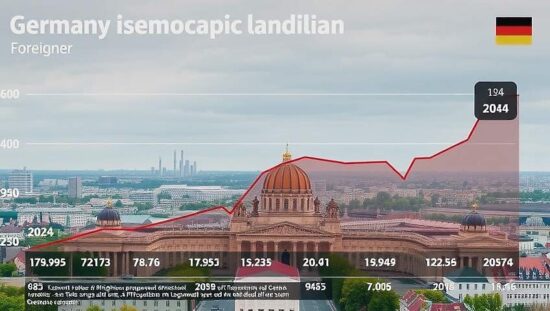Germany’s population reached approximately 83.6 million at the end of 2024, according to the German Federal Statistical Office (Destatis). This marks a 0.1% increase, following a 0.4% growth in the previous year, when the population rose by 338,000 people.
The population growth is primarily attributed to net migration, as the natural population growth, measured by the difference between births and deaths, was relatively stable, with a surplus of 330,000 in 2024, similar to the previous year. The net migration surplus, however, decreased from 660,000 to 420,000, resulting in the overall population growth being driven by the latter.
West Germany’s population grew by 136,000, or 0.2%, to 67.5 million, while the eastern states, excluding Berlin, saw a decline of 38,000, or 0.3%, to 12.4 million. Bavaria recorded the largest absolute increase, with a gain of 73,000. In relative terms, the population in Bavaria, Berlin and Hamburg grew the most, at 0.6%.
Conversely, the eastern states of Thuringia, Saxony and Saxony-Anhalt experienced the largest population declines, with decreases of 15,000, 12,000 and 9,000, respectively.
The age structure of the population also showed distinct developments. The number of people aged 60 to 79 increased by 416,000, or 2.2%, while the number of those aged 40 to 59 decreased by 323,000, or 1.4%. This disparity is largely attributed to the large birth cohort of 1964, which transitioned into the 60- to 79-year-old age group in 2024. The numbers of children and youth under 20, as well as those aged 20 to 39, remained relatively stable. The population of those aged 80 and older, at 6.1 million, increased by 14,000, or 0.2%.
The foreign population in Germany grew by 283,000, to 12.4 million, or 2.3%, while the native German population decreased by 162,000, to 71.2 million, or 0.2%. As a result, the foreigner proportion of the population rose from 14.5% to 14.8%. The proportion of foreigners varies across age groups, with the highest rates found in the 20- to 59-year-old age group, at 19.7% and the lowest in the 60-year-old and above age group, at 6.3%. Among children and youth under 20, the foreigner proportion is 15.4%. The largest foreign groups in Germany are Turks, Ukrainians, Syrians, Romanians and Poles, according to the statistics.





